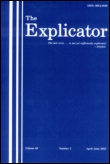Cubism in John Updike's "A Sense of Shelter." The Explicator, 70:2, 75-77

A lively debate among several literary scholars has revolved around the question of whether William Young, the protagonist in John Updike’s “A Sense of Shelter,” escapes into the unknown world of adulthood or retreats back into the warm confines of his school, the one place that resembles shelter in his life.1 Instead of focusing on the story’s thematic conclusion, I explore Updike’s use of a Cubist paint stroke to illustrate the last third of the story, as William embarks to tell Mary Landis that he has loved her since kindergarten. Through the use of several overlapping images in this last third of “A Sense of Shelter,” Updike’s artistic background casts its shadow on the world as seen through William’s perspective. Certain scenes, such as the moment when William begins to see the “planes and angles” of the setting around him, elevate the narrative descriptions with a Cubist texturing (Updike 48).
The scene shifts from a two-dimensional to a three-dimensional picture as William and Mary descend the stairs of their high school. William, who had earlier in study hall finished his geometry homework, notices the geometry surrounding them. There “was something magical in the rapid multiplication of planes and angles” in the stairwell that caused William to speak clearly for a moment (Updike 48).2 The stutter that inspired his nickname “Mip” is gone. Here Updike intricately links emotion to geom- etry. William feels his heartbeat quicken and an adrenaline rush before the beautiful, green-eyed Mary, who has always been unattainable to him. In this moment he notices the planes and angles of the stairwell. Updike studied art in Oxford, England, and four years prior to writing “A Sense of Shelter,” he mentions an obscure detail about the life of Cubist painter Georges Braque in his story “Towards Evening.”3 As a student, historian, and critic of modern art, Updike clearly knew the tenets of this art movement and was familiar with Braque’s vision of emotion as geometry. In his definition of this Cubism, philosopher Jaakko Hintikka highlights Braque’s statement that artistic interpretation or translation of emotions takes place by such concrete means as “volume, line, mass, weight” (231).
Fulfilling a second major description of Hintikka’s cubism—a clash of perceptions—William is between two worlds and therefore sees the same objects from two different perspectives at the same time.4 “Cubists often depicted the same subject from several different perspectives at one and the same time” (Hintikka 232). Though still standing in the shelter of normalcy and predictability (as he had sat in nearly the same seat in class for twelve years), William peers out to the precipitous edge of manhood.
As the story’s protagonist reaches the end of the stairwell with Mary Landis, he sees Mary in two lights... LINK TO ARTICLE
Works Cited
Detweiler, Robert. John Updike. Rev. Ed. Boston: G. K. Hall, 1984. Print.
Edwards, A. S. G. “Updike’s ‘A Sense of Shelter’.” Studies in Short Fiction 8.3 (1971): 467–68. Print.
Hintikka, Jaakko. The Intentions of Intentionality and Other New Models for Modalities. Boston: D. Reidel, 1975. Print.
Reising, R. W. “Updike’s ‘A Sense of Shelter’.” Studies in Short Fiction 7.4 (1970): 651–52. Print.
Updike, John. John Updike: The Early Stories. New York: Random, 2003. Print.
The scene shifts from a two-dimensional to a three-dimensional picture as William and Mary descend the stairs of their high school. William, who had earlier in study hall finished his geometry homework, notices the geometry surrounding them. There “was something magical in the rapid multiplication of planes and angles” in the stairwell that caused William to speak clearly for a moment (Updike 48).2 The stutter that inspired his nickname “Mip” is gone. Here Updike intricately links emotion to geom- etry. William feels his heartbeat quicken and an adrenaline rush before the beautiful, green-eyed Mary, who has always been unattainable to him. In this moment he notices the planes and angles of the stairwell. Updike studied art in Oxford, England, and four years prior to writing “A Sense of Shelter,” he mentions an obscure detail about the life of Cubist painter Georges Braque in his story “Towards Evening.”3 As a student, historian, and critic of modern art, Updike clearly knew the tenets of this art movement and was familiar with Braque’s vision of emotion as geometry. In his definition of this Cubism, philosopher Jaakko Hintikka highlights Braque’s statement that artistic interpretation or translation of emotions takes place by such concrete means as “volume, line, mass, weight” (231).
Fulfilling a second major description of Hintikka’s cubism—a clash of perceptions—William is between two worlds and therefore sees the same objects from two different perspectives at the same time.4 “Cubists often depicted the same subject from several different perspectives at one and the same time” (Hintikka 232). Though still standing in the shelter of normalcy and predictability (as he had sat in nearly the same seat in class for twelve years), William peers out to the precipitous edge of manhood.
As the story’s protagonist reaches the end of the stairwell with Mary Landis, he sees Mary in two lights... LINK TO ARTICLE
Works Cited
Detweiler, Robert. John Updike. Rev. Ed. Boston: G. K. Hall, 1984. Print.
Edwards, A. S. G. “Updike’s ‘A Sense of Shelter’.” Studies in Short Fiction 8.3 (1971): 467–68. Print.
Hintikka, Jaakko. The Intentions of Intentionality and Other New Models for Modalities. Boston: D. Reidel, 1975. Print.
Reising, R. W. “Updike’s ‘A Sense of Shelter’.” Studies in Short Fiction 7.4 (1970): 651–52. Print.
Updike, John. John Updike: The Early Stories. New York: Random, 2003. Print.
